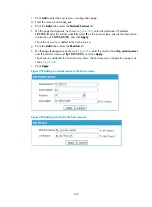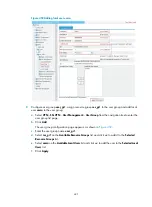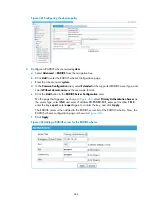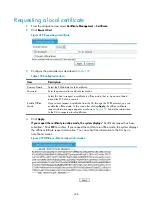
448
Managing certificates
Overview
Public Key Infrastructure (PKI) offers an infrastructure for securing network services. PKI, also called
asymmetric key infrastructure, uses a pair of keys (one private and one public) for data encryption and
decryption. Data encrypted with the public key can be decrypted only with the private key, and vice
versa.
PKI uses digital certificates to distribute and employ public keys, and provides network communication
and e-commerce with security services such as user authentication, data confidentiality, and data
integrity.
HP's PKI system provides certificate management for IPsec, and SSL.
The PKI technology can satisfy the security requirements of online transactions. As an infrastructure, PKI
has a wide range of applications. Here are some application examples:
•
VPN
—A VPN is a private data communication network built on the public communication
infrastructure. A VPN can leverage network layer security protocols (for example, IPsec) in
conjunction with PKI-based encryption and digital signature technologies to achieve confidentiality.
•
Secure
—Emails require confidentiality, integrity, authentication, and non-repudiation. PKI
can address these needs. A common secure email protocol is S/MIME, which is based on PKI and
allows for transfer of encrypted mails with signature.
•
Web
security
—For Web security, two peers can establish an SSL connection first for transparent
and secure communications at the application layer. With PKI, SSL enables encrypted
communications between a browser and a server. Both the communication parties can verify the
identity of each other through digital certificates. For more information about PKI, see
Security
Configuration Guide
.
Recommended configuration procedure
The system supports the following PKI certificate request modes:
•
Manual
—In manual mode, you need to manually retrieve a CA certificate, generate a local RSA
key pair, and submit a local certificate request for an entity.
•
Auto
—In auto mode, an entity automatically requests a certificate through the SCEP when it has no
local certificate or the present certificate is about to expire.
You can specify the PKI certificate request mode for a PKI domain. Different PKI certificate request modes
require different configurations.
Summary of Contents for MSR SERIES
Page 17: ...xv Documents 835 Websites 835 Conventions 836 Index 838 ...
Page 20: ...3 Figure 3 Initial page of the Web interface ...
Page 42: ...25 Figure 13 Firefox Web browser setting ...
Page 59: ...42 Figure 27 Checking the basic service configuration ...
Page 73: ...56 Figure 35 Sample interface statistics ...
Page 156: ...139 Figure 139 Rebooting the 3G modem ...
Page 168: ...151 Figure 152 Configuring Web server 2 ...
Page 174: ...157 Figure 158 Configure the URL filtering function ...
Page 242: ...225 Figure 233 Enabling the DHCP client on interface Ethernet 0 1 ...
Page 247: ...230 Figure 236 The page for configuring an advanced IPv4 ACL ...
Page 255: ...238 Figure 241 Advanced limit setting ...
Page 298: ...281 e Click Apply 2 Configure Router B in the same way Router A is configured ...
Page 400: ...383 Figure 387 Verifying the configuration ...
Page 405: ...388 ...
Page 523: ...506 Figure 530 Ping configuration page ...
Page 775: ...758 Figure 785 Configuring a jump node ...






























